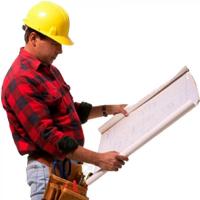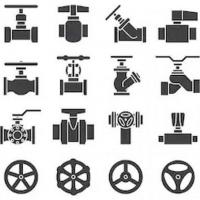All About Valves
by Guest Post on Nov 18, 2011
Valves are an indispensable part of any modern building. By opening and closing, they can control the flow of air, water, or some other liquid through the pipes and prevent the pressure from becoming too great.
There are many different types of valves, each designed for a specific purpose. These include the ball valve, butterfly valve, diagram valve, solenoid valve, check valve, piston valves, needle valve, and choke valve— and this article will discuss each of them, its design and its use in the home.
Ball valves
A ball valve is the easiest to turn off— all one has to do is turn it 90°, rather than having to turn it many times. For that reason, they are used in places where the flow needs to be shut off tightly. Because it is capable of withstanding high temperatures and pressures (482° F and 1,000 bars respectively), as well as very durable, the ball valve is one of the most versatile types of valves ever made. The flow through a ball valve is controlled utilizing a spherical disk with a port running down the middle. When the valve is open, the port is parallel to the valve's ends. Ball valves commonly serve as flush valves in toilet tanks; in oil and gas pipelines; and in some pipes.
Butterfly valves
A butterfly valve also has a disk as its closing mechanism, but it is flat rather than spherical. Opening the valve requires turning this disk one-quarter of the way around. Such valves are often preferred to ball valves because they are lighter and less expensive. Commonly used types include the electric and the air-actuated butterfly valve. In the former, the disk is turned on and off by electricity. An LED light indicates the current status of the actuator. Some of these valves have a digital positioning system (DPS) that uses a control signal to position the disk. In air-actuated valves, the disk is controlled utilizing a pneumatic pilot system. They are among the best for many purposes, as they have higher rates of flow and can withstand higher temperatures and pressures.
Another commonly used type is the spring return butterfly valve, which is equipped with a spring mechanism that closes the valve if the air pressure drops below a certain level. The spring return type is often used on oil drilling rigs; in workboats; and in farming, construction, and mining equipment.
Pipe valves— a category that also includes faucets, drains, and other things— regulate flow within pipes.
Other types of valves
The valves discussed so far are all collectively called quarter-turn valves. There are many other types. Check valves— also variously known as non-return, one- way or clack valves— are used on many household items, including irrigation sprinklers, rainwater harvesting systems, and homemade snowmakers. The fluid enters these valves through one end and exits by another. They work automatically. Needle valves, which have plungers shaped like needles, are useful in carburetors and in water heaters, where a narrow, precise flow is needed. And thermal expansion valves, with their complex layouts including a temperature-sensing bulb, have found application in refrigeration systems: They control the flow of air to the evaporator.
Popular Articles
Three Places to Spend Money on the Exterior of Your Home
When you have the exterior of your home remodeled, you are investing, time, energy and convenience into the project and you want to make sure that...
105271 Views
Homemade Headboards-Make an Upholstered or Wooden Headboard
Homemade headboards can add a lot of personality to any bedroom. They can be coordinated with existing furniture and room decor or they can be the...
80311 Views
When to Use a Brush, Roller or Sponge Brush
Brushes are a good choice for painting trim and woodwork. They are also useful for cutting in the edges around the top and bottom edges and corners...
72939 Views
Creating a Cottage Kitchen with Bead Board
Kitchen decor can range from modern and bold to elegant and elaborate by using strategic kitchen pieces. One of the most popular decorating trends...
58719 Views
Gas Fireplace Diagnostics and Troubleshooting
Follow these steps for diagnosing and troubleshooting Gas Fireplaces repairs. For the average DIYer, this may seem intimidating, depending on the...
35732 Views
Latest Articles
Why Professional Boiler Repair is Essential for Home Safety and Comfort
Maintaining a warm and safe home environment is paramount for any homeowner. Your home's boiler system plays a critical role in this, but what...
on Nov 5, 2025
How to Keep Your Home Warm in the Winter
How to Keep Your Home Warm in the WinterAs winter approaches, keeping your home warm becomes a priority for comfort and health. Efficient heating...
on Oct 29, 2025
Why Reliable Furnace Repair is Essential for Winter Comfort
As the cold season approaches, homeowners recognize the critical role that a well-functioning furnace plays in ensuring a warm and cozy living...
on Oct 29, 2025
How Much Does it Cost to Take a Bath?
Plumbers know that a bath may seem like a relaxing luxury, but the real cost extends far beyond your water bill. The average soak uses 35 to 50...
on Apr 8, 2025
10 Concrete Patio Ideas on a Budget
A concrete patio can be a game-changer for your outdoor space. It is durable, versatile, and can be customized to fit your style. But what if you...
on Mar 25, 2025
Featured Articles
What Type of Licensed Contractor Should You Hire?
on Feb 28, 2017
Hire Contractors / Estimates

Looking for a specialty project? There are many types of contractors available for your home improvement needs. Finding the right type of...
Actions
Top Categories
- Garden / Landscaping / Patio — 264
- Kitchen / Bathrooms — 240
- Real Estate / Finance — 203
- Appliance / Repair — 186
- Interior Design / Decor — 184
- HVAC / Air Conditioning — 150
- Cleaning / Maintenance — 144
- Improvements / Remodeling — 131
- Plumbing / Basements — 118
- Floors / Tile / Hardwood — 116
- Safety / Security — 114
- Doors / Garages — 113
Articles Archive
More DIY Articles
How Expert Carport Entryway Repair Can Keep Your Home Safe
Among the numerous ways we attempt to ensure our homes and keep it protected, one path is to keep the carport safe. Yes, the vast majority of us...
How to Clean Your Carpet and Protect Your Investment (Learn the Basics)
If you look at statistics, more than 50% of homes in the United States alone have carpet installed inside their homes. The purpose is actually...
Options for Cleaning the Air in Your Home
Every day, we are exposed to chemicals, toxins, dust, and dirt in our air. The air we breathe is required to continue to live, and it is a huge...
Maintenance Tips for Home and Roof Repair
There are various home repair challenges that homeowners face ranging from faulty kitchen appliances to leaking pipes. Home and roof repairs...
When to Replace Your Heater
Consider the number of damages the heating unit has so that you will know right away if you will need to buy a new one or not. You better replace...

